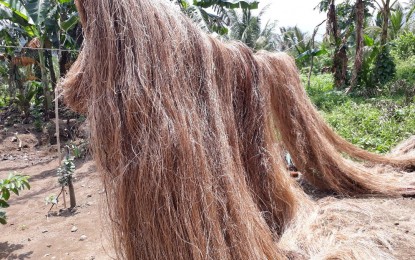
ABACA FIBER. Drying of abaca fiber in Leyte province. The bunchy-top disease that has been plaguing several areas in Eastern Visayas has significantly contributed to the drop in abaca fiber production in the region in 2022, the Philippine Industry Development Authority reported on Tuesday (Feb. 28. 2023). (PNA photo by Roel Amazona)
TACLOBAN CITY – The bunchy-top disease that has been plaguing several areas in Eastern Visayas has significantly contributed to the drop in abaca fiber production in the region in 2022, the Philippine Industry Development Authority (PHilFIDA) said on Tuesday.
From 4,768 metric tons (MT) output in 2021, the volume dropped to 3,835 MT last year, or a 19.55 percent reduction, said PhilFIDA Regional Director Wilardo Sinahon.
“The major contributor was the abaca bunchy-top disease, which has greatly affected our abaca production since early 2000. Currently, we have no data on the exact number of affected areas since almost all farms in the region are now infested,” Sinahon told the Philippine News Agency.
Citing estimates, the official said the disease has been plaguing about 60 percent of the existing 28,217 hectares of abaca plantations in the region’s six provinces.
From about 10,000 metric tons output in 2009 to 2010, the production has decreased to only 3,000 to 4,000 annually in recent years, according to Sinahon.
The minimal funds are a huge setback in PhilFIDA’s disease management activities. The region only gets PHP6 million to fight the disease every year, way low than the PHP50 million yearly requirement, according to the official.
According to an American journal of botany, the bunchy-top is the country's most serious disease of abaca; symptoms include narrow, brittle leaves with bleached upturned margins.
Aside from disease infestation, other factors that pulled down the yield were the impact of Typhoon Odette that devastated Southern Leyte farms in late 2021, slow expansion of new planted areas due to limited planting materials production, and the decrease in the price of low-grade abaca fibers.
Southern Leyte is the third top-producing province in the region with a total yield of 629.42 MT in 2022. Its production has decreased by 15.37 percent compared to 2021.
Other provinces that recorded production decline are Eastern Samar (-47.84 percent), Biliran (-27.82 percent), and Northern Samar (-13.76 percent).
The provinces of Samar and Leyte posted a production increase at 128.74 percent and 21.21 percent, respectively.
Eastern Visayas was the top fiber producer in the country until abaca disease wreaked havoc in many farms in the region in early 2000.
Known globally as Manila hemp, abaca is processed into cordage, pulp and specialty paper and fibercrafts including handwoven fabric.
The region has five grading-baling establishments that ship raw fiber overseas such as United Kingdom, France, Germany, Spain, Japan, India, Korea, Hong Kong, Indonesia, United States, and Canada. (PNA)
